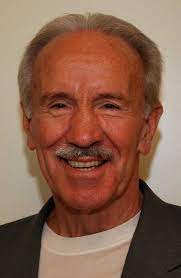John Grinder facts for kids
Quick facts for kids
John Grinder
|
|
|---|---|

John Grinder
|
|
| Born | January 10, 1940 (age 85) United States
|
| Spouse(s) | Carmen Bostic St Clair |
| School | Neuro-linguistic programming |
|
Main interests
|
Transformational grammar, NLP modeling, Cybernetic epistemology |
|
Notable ideas
|
Neuro-linguistic programming, New Code of NLP |
|
Influences
|
|
|
Influenced
|
|
John Grinder was born on January 10, 1940, in the United States. He is an American linguist, which means he studies language. He is also a writer, a business advisor, and a speaker.
John Grinder is famous for helping to create something called neuro-linguistic programming (NLP) with Richard Bandler. NLP is a way of understanding how people think, communicate, and behave. It helps people learn new skills and make changes in their lives.
Grinder also works with Carmen Bostic St. Clair at a company called Quantum Leap Inc. They lead workshops and seminars around the world to teach people about NLP.
Contents
John Grinder's Early Life and Work
John Grinder went to the University of San Francisco in the early 1960s. He earned a degree in psychology, which is the study of the mind and behavior.
After college, Grinder joined the United States Army. He served as a captain in the US Special Forces in Europe during the Cold War. Later, he worked for a US intelligence agency.
In the late 1960s, he went back to school to study linguistics. He earned his Ph.D. degree from the University of California, San Diego in 1971. His research focused on how sentences are put together in English.
In the early 1970s, Grinder worked at Rockefeller University. Then, he became a professor at the University of California, Santa Cruz (UCSC). He taught students and did research on language. He studied the ideas of Noam Chomsky about how language works.
Grinder also wrote a textbook about linguistics with Suzette Elgin. In 2005, he published an article with Tom Malloy and Carmen Bostic St. Clair about how new ideas emerge.
How Neuro-Linguistic Programming (NLP) Started
In 1972, while John Grinder was teaching at UCSC, a psychology student named Richard Bandler asked for his help. Bandler was trying to understand and copy the methods of a type of therapy called Gestalt therapy.
Bandler and his friend Frank Pucelik had recorded and studied sessions with Fritz Perls, who created Gestalt therapy. Grinder joined their discussions and offered his ideas. He made a big impression on them.
Bandler and Pucelik invited Grinder to work with them. They formed a close group, and other students also helped. Their hard work led to the creation of what we now call NLP.
Grinder and Bandler then studied other famous therapists. They looked at how Virginia Satir helped families and how Milton Erickson used hypnosis. They wrote several books about what they learned from these experts. These books became the basic ideas for NLP.
The group started holding seminars and practice sessions. This allowed them to test their new ideas and teach them to others. Books like Frogs into Princes were published from these seminars.
During this time, other talented students and therapists joined the group. These included Robert Dilts, Leslie Cameron-Bandler, Judith DeLozier, Stephen Gilligan, and David Gordon. They are sometimes called the "second generation" of NLP developers.
Around 1977, the original group of Bandler, Grinder, and their associates stopped working together. Some members then took NLP in their own directions. For a while, some of their books were not available due to legal issues between the co-authors. However, important books like Structure I & II and Patterns I & II were later republished.
Richard Bandler tried to claim ownership of the term "neuro-linguistic programming." But it was decided that the term was general and could not be trademarked. Grinder and Bandler settled their legal issues around 2001. This helped NLP continue to grow as a field.
The "New Code" of NLP
Between 1982 and 1987, John Grinder worked with Judith DeLozier to create the "New Code of NLP." This new approach was greatly influenced by Gregory Bateson, an anthropologist who focused on how systems work together. Grinder and Bateson had met in the 1970s.
The "New Code" added important ideas about "ecology" and the unconscious mind to NLP. "Ecology" in NLP means thinking about how a change in one part of a person's life might affect other parts. It's like asking: "What good things will happen from this change? What other effects might there be? Is this still a good idea?"
The ideas from these seminars were written down and published in 1987 in a book called Turtles All the Way Down; Prerequisites to Personal Genius.
John Grinder and Carmen Bostic St. Clair have continued to develop the New Code of NLP. They still teach public seminars about NLP around the world. In 2001, Grinder and Bostic St. Clair published Whispering in the Wind. In this book, they suggested ways for NLP to improve and become a more scientific field. Grinder strongly encourages people in NLP to focus on "modeling," which means studying and understanding how highly successful people achieve their results.
See also
 In Spanish: John Grinder para niños
In Spanish: John Grinder para niños

